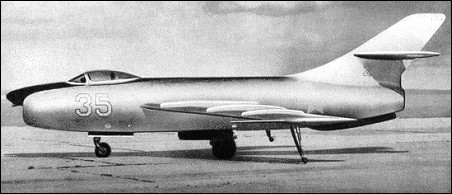 |
Yakovlev Yak-501949 |  |
| ALL-WEATHER FIGHTER | Virtual Aircraft Museum / USSR / Russia / Yakovlev |
 |
With V-VS formulation of a requirement for a single-seat limited all-weather fighter, the Yakovlev OKB developed the Yak-50 in competition with the MiG-15Pbis. The wing, mounted in full mid position, was a two-spar structure of constant 12% thickness sweptback 45° at quarter chord. The OKB used magnesium alloys in the structure for the first time to any great extent as a contribution to weight reduction, a further weight-saving measure being the adoption of a velosipedno tipa, or "bicycle type" undercarriage. This zero-track arrangement, earlier tested by the Yak-25, comprised a single nosewheel member and a twin-wheel main unit, the latter taking 85% of the total aircraft weight; in addition, small outrigger stabilising wheels retracted into wingtip fairings. Power was provided by a single 2700kg Klimov VK-1 turbojet, armament consisted of two 23mm NR-23 cannon and provision was made for the installation of a single-antenna, fixed-scan, manually-tracked Korshun (Kite) AI radar in a housing above the nose air intake splitter. The first of three Yak-50 prototypes was flown on 15 July 1949, several months before the first radar-equipped MiG-15Pbis (SP-1), and demonstrated an outstanding speed performance, exceeding Mach=1.01 in a shallow dive on several occasions during manufacturer's trials and Mach=1.048 during State Acceptance testing. It could take-off within 578m and land within 965m, but in more than a 18km/h crosswind, the Yak-50 tended to swerve from the runway, and it was barely controllable on a wet surface. In level flight at speeds between Mach=0.92 and 0.97, the Yak-50 suffered lateral oscillation preventing gun aiming. These shortcomings, coupled with the fact that the Mikoyan-Gurevich OKB was offering the potentially superior Izumrud radar-equipped MiG-17P, led to termination on 30 May 1950.

|  COMPANY PROFILE | ||||||||||||||||||||||||||||||||||||||||
 |

|


